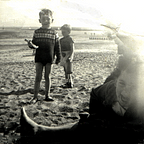The Fall of Benjamin Haydon: Part 1
In April 1846 there were two exhibitions at the Egyptian Hall in London. One had crowds queuing down the street. The other...
It was the ‘General Tom Thumb, the Midget’ exhibition that seems to have pushed Benjamin Robert Haydon over the edge.
Haydon (1786–1846) had achieved early success as a historical painter: big themes and even bigger canvases. A close friend of Keats and Wordsworth, he included both in his Christ’s Entry into Jerusalem.
The painting also featured in one of the most famous literary parties, The Night of the Immortals, held at Haydon’s home and recorded in his journal
On December 28th {1817} the immortal dinner came off in my painting-room, with Jerusalem towering up behind... Wordsworth was in fine cue, and we had a glorious set-to — on Homer, Shakespeare, Milton and Virgil.
Perhaps not everyone’s idea of ‘a glorious set to’ but Haydon saw himself as a fellow Romantic hero. This proved problematic when it came making a living. His dogged refusal to consider client requests (‘Could you do something a little smaller Ben? I’d need to remove the ceiling for that one’) led to a number of falling-out with key patrons.
His first major run-in was symbolically self-destructive. An early work Dentatus was selected for exhibition by he Royal Academy, essentially the closest equivalent to a state sponsor. This was a major achievement for a young artist but Haydon was enraged when the committee hung it in a small side-room instead of in the great hall.[1] A life-long rift ensued.
That left a very narrow niche market for his huge, bombastic pieces. His portraits were more in demand but Haydon was dismissive of what he considered hack work needed to pay the money lenders.
In 1823 he was finishing The Raising of Lazarus when he was carted off to the debtors prison for the first of many stays. This tarnished his reputation but also inspired sympathy and interest. His cell time also provided source material for The Mock Election (1827) which he sold to King George IV.
There were occasional successes over the next two decades: most notably The Reform Banquet (1832) and Cassandra (1834). Haydon also had important backers in high places, including Robert Peel (Home Secretary and then Prime Minister) and culturally influential ones: most notably Elizabeth Barrett and the popular Mrs Mitford.
At an existential level, however, the trajectory was relentlessly downward. Five of his children had contracted tuberculosis and died in early childhood. His wife and the remaining three faced dire poverty.
What kept him going was an unwavering belief in his own artistic importance. In a final roll of the dice, he decided to unveil The Banishment of Aristides and other recent work to the world. To do so, he hired rooms in the Egyptian Gallery where started what promised to be a glittering career.
In April 1846 Haydon out 400 invitation to a private viewing, including all the great and the good of London society. On a rainy day only four people came but he despite a good review in The Times the exhibition continued to do pitiful business.
Going up against P.T Barnum’s star performer in London’s Egyptian Hall proved a humiliating mismatch. From March until July 1945, the 32 inch ‘general’ (actually an eight year-old dwarf) drew huge crowds — and the biggest hitters in Victorian Britain. The Queen herself visited three times, while Dickens organised Thumb parties of celebrity pals.
In the same building Haydon sat alone with his paintings. He wrote in his diary:
They rush by thousands to see Thumb. They push, they fight, they scream…They see my boards, and don’t read them. Their eyes are open but their sense is shut… I would not have believed it of the English people.
What hurt most was that the rejection felt personal. Many of the cultural big-wigs flocking to see Thumb in the Egyptian Hall were men who Haydon knew personally and considered his peers: the painter, Landseer, the famous actor Macready. None bothered to cross the corridor.
During Easter week 12,000 paid to see Thumb. Only 133 adults and one child came to the Haydon exhibition. It was forced to close in May, freeing up space for more Thumb fans to see their little hero.
In his journal Haydon recorded this rejection in epic, Biblical terms. Dickens, who was one of the 133 , would later offer a more earthly explanation. The exhibition he stated brutally, ‘was quite marvellous in its badness’.
